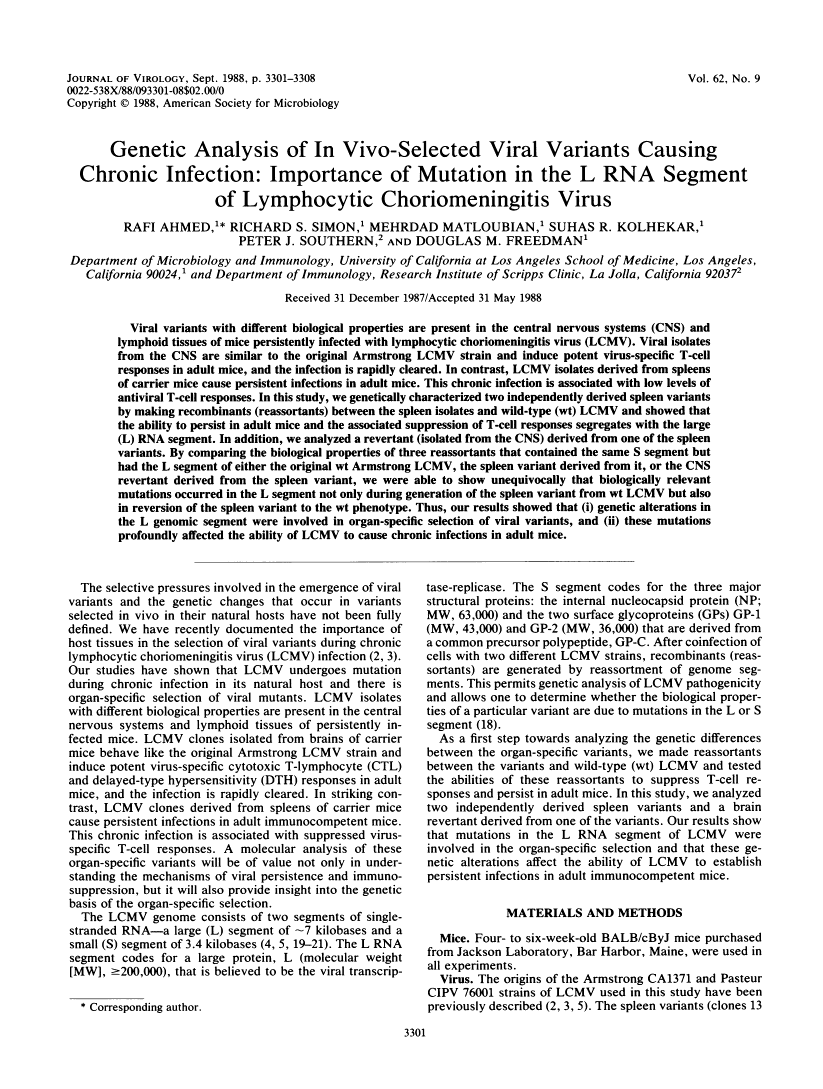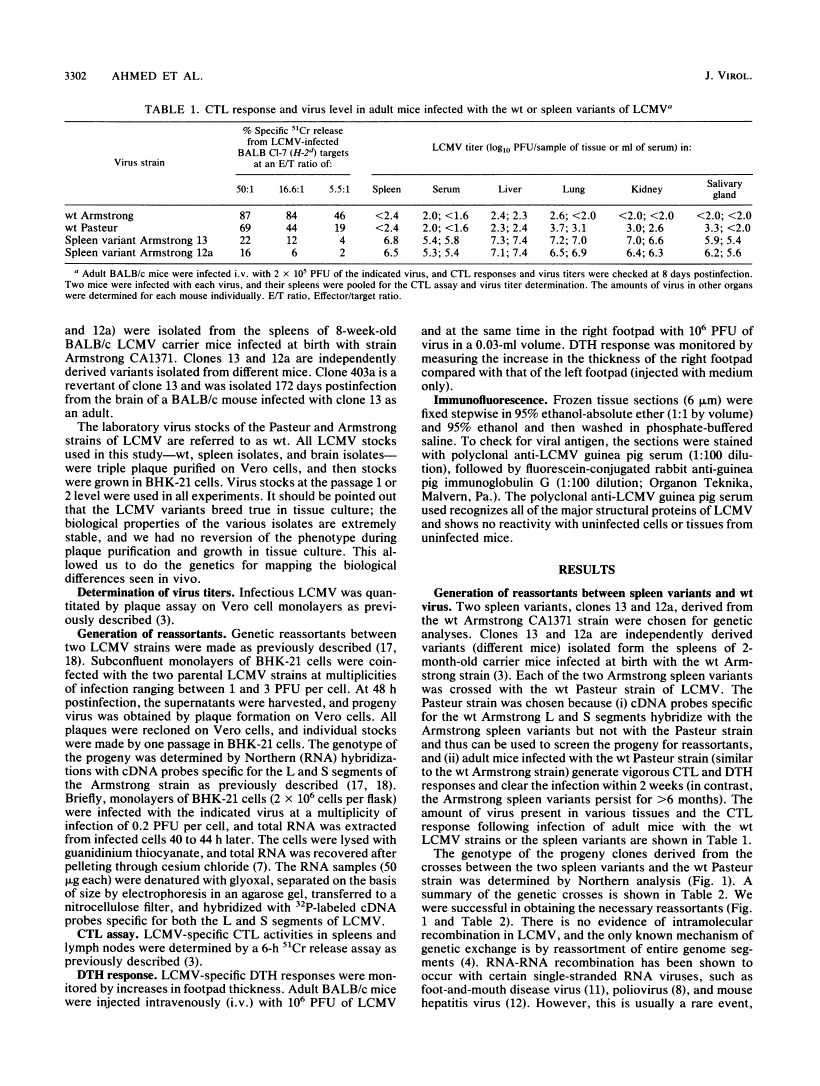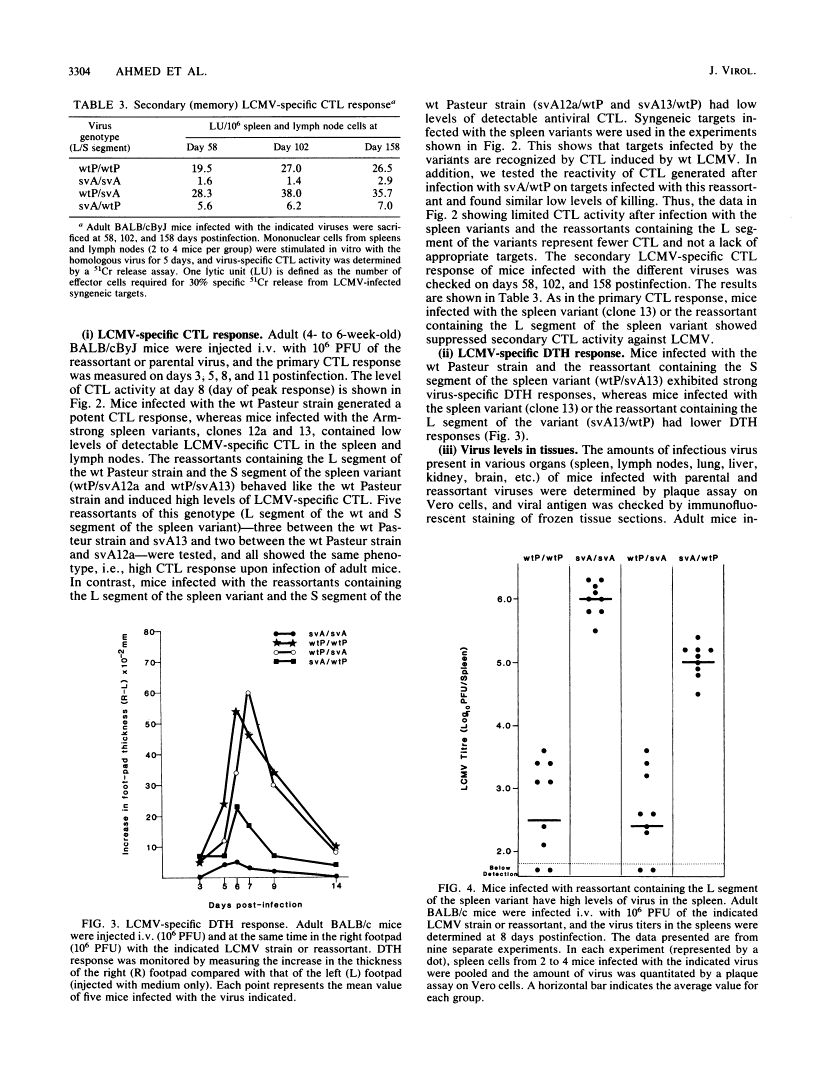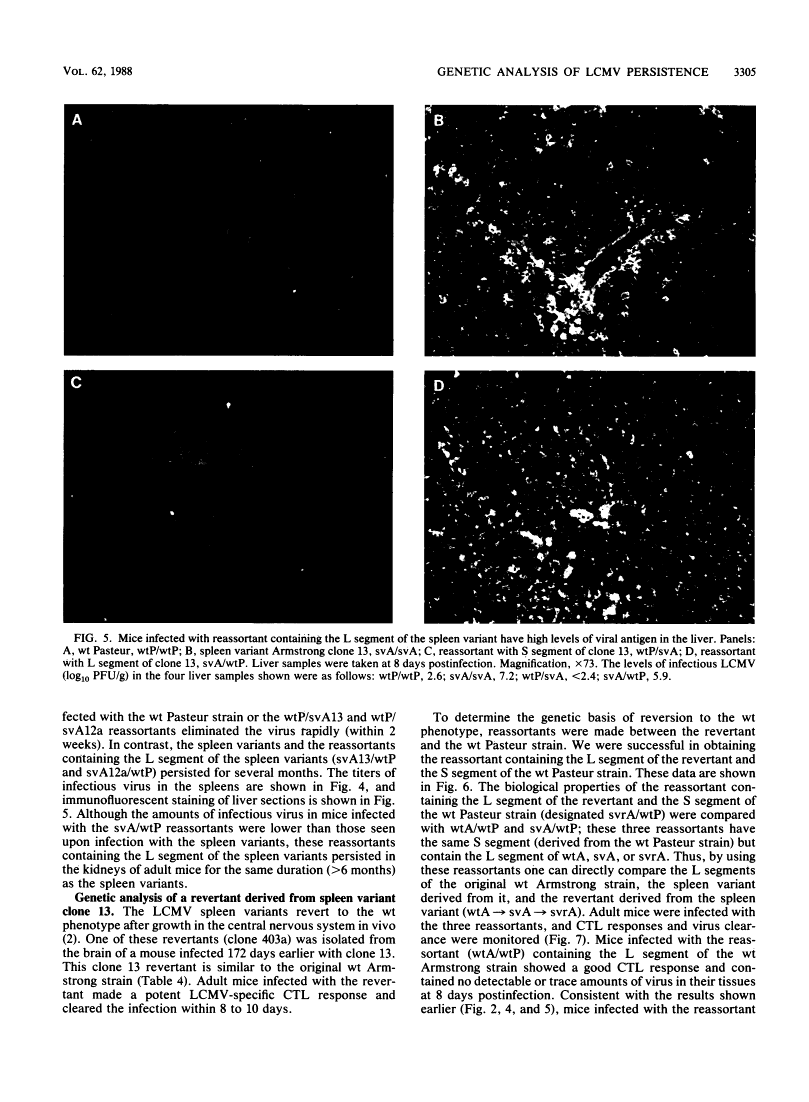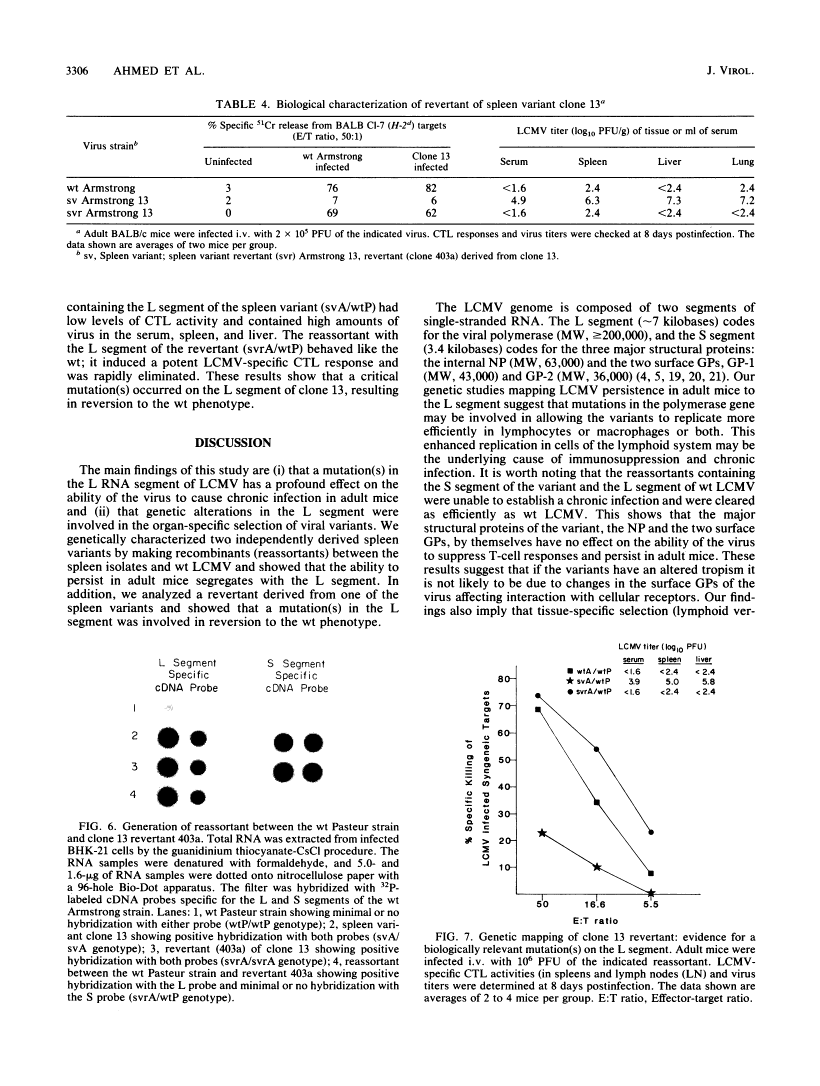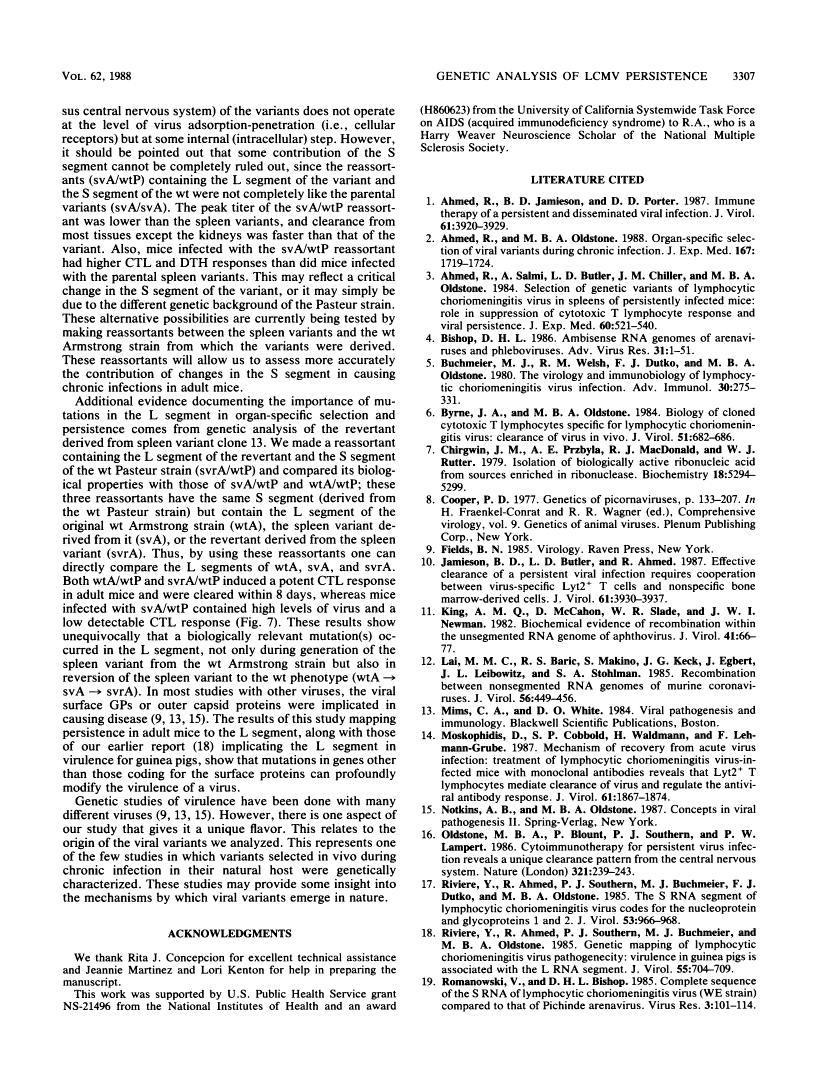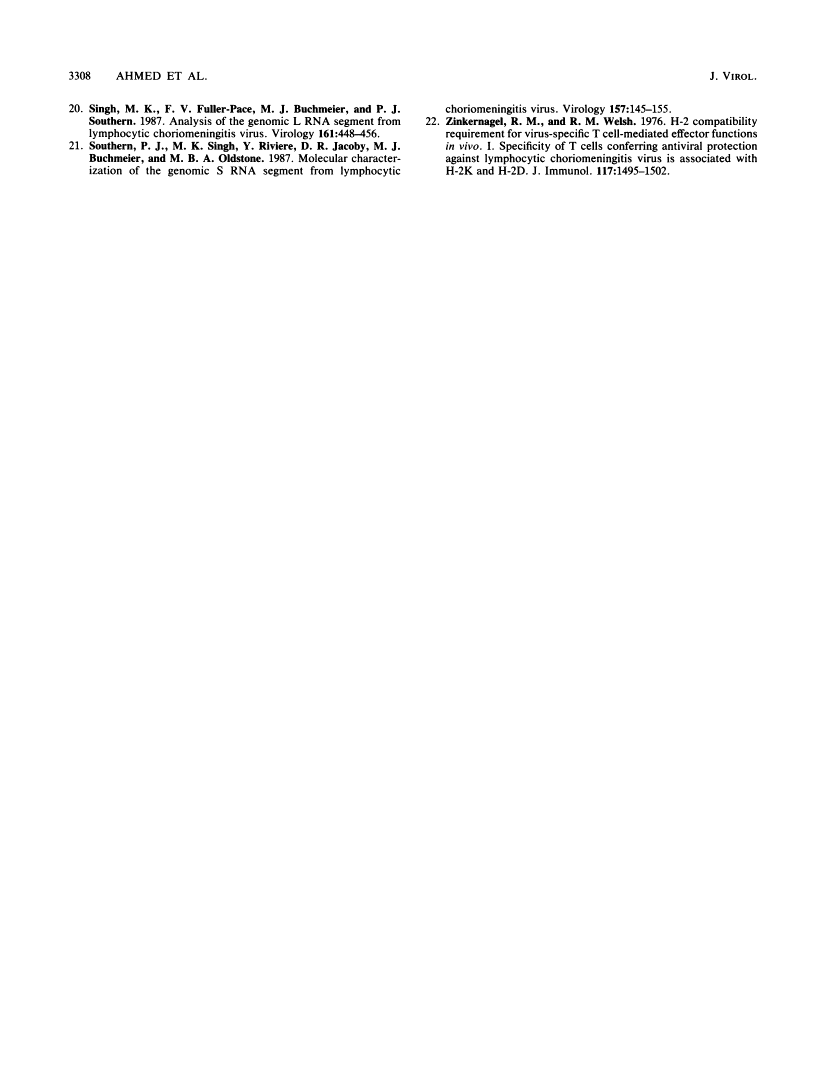Abstract
Free full text

Genetic analysis of in vivo-selected viral variants causing chronic infection: importance of mutation in the L RNA segment of lymphocytic choriomeningitis virus.
Abstract
Viral variants with different biological properties are present in the central nervous systems (CNS) and lymphoid tissues of mice persistently infected with lymphocytic choriomeningitis virus (LCMV). Viral isolates from the CNS are similar to the original Armstrong LCMV strain and induce potent virus-specific T-cell responses in adult mice, and the infection is rapidly cleared. In contrast, LCMV isolates derived from spleens of carrier mice cause persistent infections in adult mice. This chronic infection is associated with low levels of antiviral T-cell responses. In this study, we genetically characterized two independently derived spleen variants by making recombinants (reassortants) between the spleen isolates and wild-type (wt) LCMV and showed that the ability to persist in adult mice and the associated suppression of T-cell responses segregates with the large (L) RNA segment. In addition, we analyzed a revertant (isolated from the CNS) derived from one of the spleen variants. By comparing the biological properties of three reassortants that contained the same S segment but had the L segment of either the original wt Armstrong LCMV, the spleen variant derived from it, or the CNS revertant derived from the spleen variant, we were able to show unequivocally that biologically relevant mutations occurred in the L segment not only during generation of the spleen variant from wt LCMV but also in reversion of the spleen variant to the wt phenotype. Thus, our results showed that (i) genetic alterations in the L genomic segment were involved in organ-specific selection of viral variants, and (ii) these mutations profoundly affected the ability of LCMV to cause chronic infections in adult mice.
Full text
Full text is available as a scanned copy of the original print version. Get a printable copy (PDF file) of the complete article (1.8M), or click on a page image below to browse page by page. Links to PubMed are also available for Selected References.
Images in this article
Selected References
These references are in PubMed. This may not be the complete list of references from this article.
- Ahmed R, Jamieson BD, Porter DD. Immune therapy of a persistent and disseminated viral infection. J Virol. 1987 Dec;61(12):3920–3929. [Europe PMC free article] [Abstract] [Google Scholar]
- Ahmed R, Oldstone MB. Organ-specific selection of viral variants during chronic infection. J Exp Med. 1988 May 1;167(5):1719–1724. [Europe PMC free article] [Abstract] [Google Scholar]
- Ahmed R, Salmi A, Butler LD, Chiller JM, Oldstone MB. Selection of genetic variants of lymphocytic choriomeningitis virus in spleens of persistently infected mice. Role in suppression of cytotoxic T lymphocyte response and viral persistence. J Exp Med. 1984 Aug 1;160(2):521–540. [Europe PMC free article] [Abstract] [Google Scholar]
- Bishop DH. Ambisense RNA genomes of arenaviruses and phleboviruses. Adv Virus Res. 1986;31:1–51. [Europe PMC free article] [Abstract] [Google Scholar]
- Buchmeier MJ, Welsh RM, Dutko FJ, Oldstone MB. The virology and immunobiology of lymphocytic choriomeningitis virus infection. Adv Immunol. 1980;30:275–331. [Abstract] [Google Scholar]
- Byrne JA, Oldstone MB. Biology of cloned cytotoxic T lymphocytes specific for lymphocytic choriomeningitis virus: clearance of virus in vivo. J Virol. 1984 Sep;51(3):682–686. [Europe PMC free article] [Abstract] [Google Scholar]
- Chirgwin JM, Przybyla AE, MacDonald RJ, Rutter WJ. Isolation of biologically active ribonucleic acid from sources enriched in ribonuclease. Biochemistry. 1979 Nov 27;18(24):5294–5299. [Abstract] [Google Scholar]
- Jamieson BD, Butler LD, Ahmed R. Effective clearance of a persistent viral infection requires cooperation between virus-specific Lyt2+ T cells and nonspecific bone marrow-derived cells. J Virol. 1987 Dec;61(12):3930–3937. [Europe PMC free article] [Abstract] [Google Scholar]
- King AM, McCahon D, Slade WR, Newman JW. Biochemical evidence of recombination within the unsegmented RNA genome of aphthovirus. J Virol. 1982 Jan;41(1):66–77. [Europe PMC free article] [Abstract] [Google Scholar]
- Lai MM, Baric RS, Makino S, Keck JG, Egbert J, Leibowitz JL, Stohlman SA. Recombination between nonsegmented RNA genomes of murine coronaviruses. J Virol. 1985 Nov;56(2):449–456. [Europe PMC free article] [Abstract] [Google Scholar]
- Moskophidis D, Cobbold SP, Waldmann H, Lehmann-Grube F. Mechanism of recovery from acute virus infection: treatment of lymphocytic choriomeningitis virus-infected mice with monoclonal antibodies reveals that Lyt-2+ T lymphocytes mediate clearance of virus and regulate the antiviral antibody response. J Virol. 1987 Jun;61(6):1867–1874. [Europe PMC free article] [Abstract] [Google Scholar]
- Oldstone MB, Blount P, Southern PJ, Lampert PW. Cytoimmunotherapy for persistent virus infection reveals a unique clearance pattern from the central nervous system. Nature. 1986 May 15;321(6067):239–243. [Abstract] [Google Scholar]
- Riviere Y, Ahmed R, Southern PJ, Buchmeier MJ, Dutko FJ, Oldstone MB. The S RNA segment of lymphocytic choriomeningitis virus codes for the nucleoprotein and glycoproteins 1 and 2. J Virol. 1985 Mar;53(3):966–968. [Europe PMC free article] [Abstract] [Google Scholar]
- Riviere Y, Ahmed R, Southern PJ, Buchmeier MJ, Oldstone MB. Genetic mapping of lymphocytic choriomeningitis virus pathogenicity: virulence in guinea pigs is associated with the L RNA segment. J Virol. 1985 Sep;55(3):704–709. [Europe PMC free article] [Abstract] [Google Scholar]
- Romanowski V, Matsuura Y, Bishop DH. Complete sequence of the S RNA of lymphocytic choriomeningitis virus (WE strain) compared to that of Pichinde arenavirus. Virus Res. 1985 Sep;3(2):101–114. [Abstract] [Google Scholar]
- Singh MK, Fuller-Pace FV, Buchmeier MJ, Southern PJ. Analysis of the genomic L RNA segment from lymphocytic choriomeningitis virus. Virology. 1987 Dec;161(2):448–456. [Abstract] [Google Scholar]
- Southern PJ, Singh MK, Riviere Y, Jacoby DR, Buchmeier MJ, Oldstone MB. Molecular characterization of the genomic S RNA segment from lymphocytic choriomeningitis virus. Virology. 1987 Mar;157(1):145–155. [Abstract] [Google Scholar]
- Zinkernagel RM, Welsh RM. H-2 compatibility requirement for virus-specific T cell-mediated effector functions in vivo. I. Specificity of T cells conferring antiviral protection against lymphocytic choriomeningitis virus is associated with H-2K and H-2D. J Immunol. 1976 Nov;117(5 Pt 1):1495–1502. [Abstract] [Google Scholar]
Associated Data
Articles from Journal of Virology are provided here courtesy of American Society for Microbiology (ASM)
Full text links
Read article at publisher's site: https://doi.org/10.1128/jvi.62.9.3301-3308.1988
Read article for free, from open access legal sources, via Unpaywall:
https://jvi.asm.org/content/jvi/62/9/3301.full.pdf
Free to read at jvi.asm.org
http://jvi.asm.org/cgi/content/abstract/62/9/3301
Free after 4 months at jvi.asm.org
http://jvi.asm.org/cgi/reprint/62/9/3301
Citations & impact
Impact metrics
Citations of article over time
Article citations
Molecular Engineering of a Mammarenavirus with Unbreachable Attenuation.
J Virol, 97(1):e0138522, 19 Dec 2022
Cited by: 3 articles | PMID: 36533953 | PMCID: PMC9888291
CD8 T-cell heterogeneity during T-cell exhaustion and PD-1-targeted immunotherapy.
Int Immunol, 34(11):571-577, 01 Oct 2022
Cited by: 5 articles | PMID: 35901837 | PMCID: PMC9533227
Review Free full text in Europe PMC
Persistent lentivirus infection induces early myeloid suppressor cells expansion to subvert protective memory CD8 T cell response✰,✰✰.
EBioMedicine, 60:103008, 24 Sep 2020
Cited by: 3 articles | PMID: 32979832 | PMCID: PMC7519271
Viral Strain Determines Disease Symptoms, Pathology, and Immune Response in Neonatal Rats with Lymphocytic Choriomeningitis Virus Infection.
Viruses, 11(6):E552, 14 Jun 2019
Cited by: 4 articles | PMID: 31207945 | PMCID: PMC6631398
Arenavirus Quasispecies and Their Biological Implications.
Curr Top Microbiol Immunol, 392:231-276, 01 Jan 2016
Cited by: 23 articles | PMID: 26472215 | PMCID: PMC7122398
Review Free full text in Europe PMC
Go to all (38) article citations
Similar Articles
To arrive at the top five similar articles we use a word-weighted algorithm to compare words from the Title and Abstract of each citation.
Selection of genetic variants of lymphocytic choriomeningitis virus in spleens of persistently infected mice. Role in suppression of cytotoxic T lymphocyte response and viral persistence.
J Exp Med, 160(2):521-540, 01 Aug 1984
Cited by: 528 articles | PMID: 6332167 | PMCID: PMC2187458
Organ-specific selection of viral variants during chronic infection.
J Exp Med, 167(5):1719-1724, 01 May 1988
Cited by: 105 articles | PMID: 3367096 | PMCID: PMC2188938
Molecular basis of organ-specific selection of viral variants during chronic infection.
J Virol, 65(8):4242-4247, 01 Aug 1991
Cited by: 55 articles | PMID: 2072451 | PMCID: PMC248861
Molecular basis of viral persistence: a single amino acid change in the glycoprotein of lymphocytic choriomeningitis virus is associated with suppression of the antiviral cytotoxic T-lymphocyte response and establishment of persistence.
J Virol, 65(4):1863-1869, 01 Apr 1991
Cited by: 131 articles | PMID: 1840619 | PMCID: PMC239996
